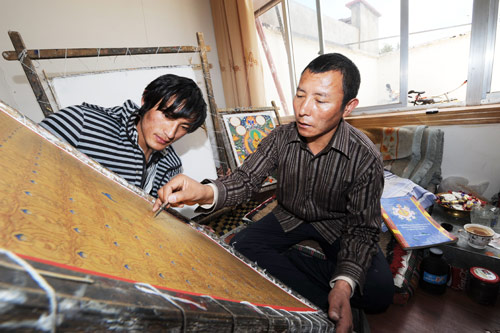
 'Taken 2' grabs movie box office crown
'Taken 2' grabs movie box office crown
 Rihanna's 'Diamonds' tops UK pop chart
Rihanna's 'Diamonds' tops UK pop chart
 Fans get look at vintage Rolling Stones
Fans get look at vintage Rolling Stones
 Celebrities attend Power of Women event
Celebrities attend Power of Women event
 Ang Lee breaks 'every rule' to make unlikely new Life of Pi film
Ang Lee breaks 'every rule' to make unlikely new Life of Pi film
 Rihanna almost thrown out of nightclub
Rihanna almost thrown out of nightclub
 'Dark Knight' wins weekend box office
'Dark Knight' wins weekend box office
 'Total Recall' stars gather in Beverly Hills
'Total Recall' stars gather in Beverly Hills
Pious paintings
Updated: 2012-11-26 09:54
By Chen Nan (China Daily)
|
|||||||||
 |
|
Zekyid learns thangka painting from his teacher Phuntso Dorje at Pandedajie School in Lhasa. |
"I want to share thangka culture with people and pass it down to another generation."
Thangka has been included on the National Intangible Cultural Heritage List since 2006. The show's artists practice the Menbris style of thangka painting that has flourished since the 15th century.
The 10 painters, who have studied thangka for more than seven years, come from Pandedajie School, founded by Fujian province native Zhang Li.
Zhang, who has owned two real estate consulting companies, visited Tibet in 2000. She fell in love with the pure and holy land, and was especially amazed by thangka, which she first saw in an ancient temple.
Her understanding of money transformed when she realized her 2,000 yuan ($321) jeans cost as much as a semester of school for 200 students.
"I don't want to give them money or donate clothes because that doesn't comprehensively solve the problem," she says.
In 2003, she decided to open a charitable school that offers free classes to poor students.
The name, Pandedajie, according to Zhang, means "benefiting others" and "spreading" in Tibetan.
The school offers sustainable ways to help children learn skills and earn livings after graduation. Zhang visited Tibet's temples to find teachers. A year later, the school opened in Lhasa.
The school's teacher is 46-year-old Phuntso Dorje, who was born in Xigaze.
He became a monk at 16 and learned thangka painting under Tashilhunpo Monastery's chief painter Kelsangla for four years.
Since then, he has continued to study with Lozangla, the painter of 10th Panchen Lama of the Tashilhunpo Monastery.
He also became the first person to publish an instructional book about thangka painting in 2006.
The painters always start with the deities' heads. They must know Tibetan and Buddhist history, and also be skilled at fresco painting and repair.
The deities express their thoughts through specific hand gestures. There are many rules about their depictions that have been passed down for centuries.
Most Viewed
Editor's Picks

|

|

|

|

|

|
Today's Top News
Health new priority for quake zone
Xi meets US top military officer
Japan's boats driven out of Diaoyu
China mulls online shopping legislation
Bird flu death toll rises to 22
Putin appoints new ambassador to China
Japanese ships blocked from Diaoyu Islands
Inspired by Guan, more Chinese pick up golf
US Weekly

|

|







